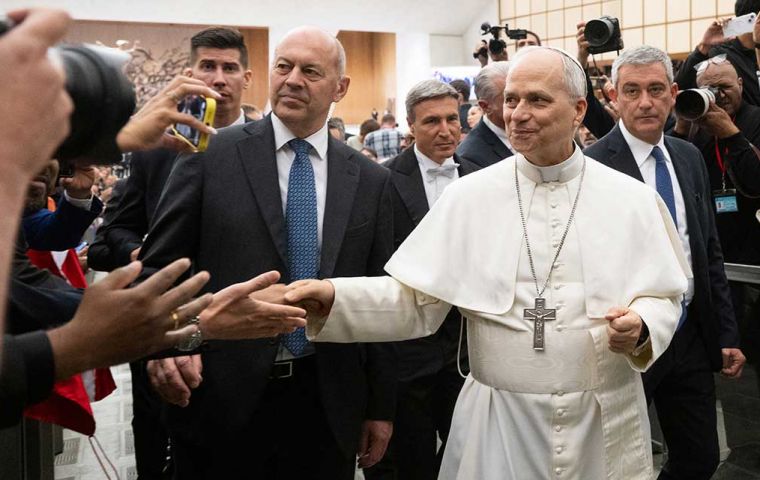MercoPress. South Atlantic News Agency
Vatican has a long track record of mediation, including Argentina, Chile, Cuba
 Pope Leo XIV walks down to greet journalists at a meeting in the Paul VI audience hall ten days ago 2025.
Pope Leo XIV walks down to greet journalists at a meeting in the Paul VI audience hall ten days ago 2025. Washington, Kyiv and several of its European allies welcomed Pope Leo XIV’s offer to host peace talks between Ukraine and Russia at the Vatican. In recent decades, the Holy See has played a key role in helping resolve a number of international conflicts.
“The Holy See is ready to bring enemies face to face and eye to eye,” Pope Leo XIV declared last week, speaking to representatives of the 23 Eastern Christian Churches and referencing the ongoing war in Ukraine.
Italian Prime Minister Giorgia Meloni said May 19 that Donald Trump, Volodymyr Zelenskyy, and several of Kyiv’s European allies reportedly welcomed his offer to mediate, echoing the diplomacy of his predecessor, Pope Francis.
While these remarks place the new pope squarely in Francis’ diplomatic footsteps, the Holy See’s involvement in conflict resolution stretches back more than a century. During World War I, Pope Benedict XV made repeated—but unsuccessful—pleas for peace. Since then, the Vatican has helped mediate a number of major geopolitical disputes, including tensions between Argentina and Chile, and the thaw in U.S.–Cuba relations.
Peace between Argentina and Chile
At the outset of his pontificate, Pope John Paul II focused on the territorial dispute between Argentina and Chile, which had dragged on for more than a century. The two neighbors were fighting over control of the Beagle Channel, located at the southern tip of South America. Tensions escalated in 1982, when Argentina invaded the Falkland Islands, triggering a brief war with the United Kingdom. Chilean dictator Augusto Pinochet was the only South American leader to openly side with London.
John Paul II intervened, determined to ensure that the fragile relationship “would not degenerate into a shameful armed conflict, but instead be resolved once and for all,” as he said in an April 1982 address. Two years later, his mediation bore fruit: the two countries signed the Treaty of Peace and Friendship at the Vatican. The agreement settled the border through the Strait of Magellan and laid out mutual navigation rights.
Cuba–U.S. Rapprochement
When President Barack Obama met with Pope Francis in March 2013, Cuba was on the agenda. Obama had just authorized secret talks with the Cuban government aimed at restoring diplomatic ties.
Following their conversation, the pope wrote two letters—one to Obama and one to Cuban President Raúl Castro—urging both to resolve “humanitarian issues of common interest, including the situation of certain detainees,” and to open a new chapter in their relationship, the Vatican later explained.
On 17 Dec. 2014, Obama and Castro publicly announced the reestablishment of diplomatic relations between Washington and Havana. The United States agreed to ease parts of its longstanding economic embargo and remove Cuba from its list of state sponsors of terrorism. US prisoners held in Cuba were also released.
Though Canada hosted the secret talks, U.S. officials credited the Vatican with playing a decisive role. “I want to thank His Holiness, Pope Francis, whose moral example shows us the importance of pursuing the world as it should be, rather than simply settling for the world as it is,” Obama said.
That thaw came to an abrupt halt in 2017 when Donald Trump took office. The Republican president recalled most U.S. diplomats from Havana and, in 2021, put Cuba back on the terrorism list. (La Croix International, French edition by Juiette Vienot de Vaublanc).
![“Working directly with President [Donald] Trump and Congress, we accomplished what no one else could,” Patel stressed](/data/cache/noticias/108417/130x80/fbi.jpg)



Top Comments
Disclaimer & comment rulesCommenting for this story is now closed.
If you have a Facebook account, become a fan and comment on our Facebook Page!